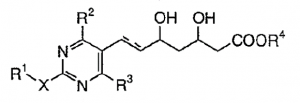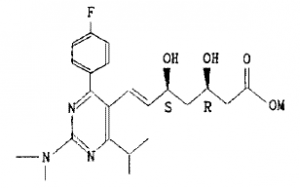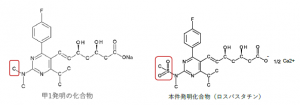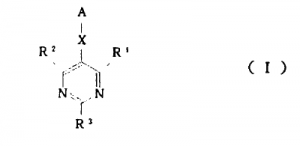Case Information:
- Case: Pyrimidine Derivative Case
- Court, Case No.: Grand Panel of IP High Court ((H28) 2016 (Gyo-Ke) 10182, 10184))
- Date: April 13, 2018
- Parties: [Plaintiff] Nippon Chemiphar Co., Ltd.(2016(Gyo-Ke)10182) [Plaintiff] X (2016(Gyo-Ke)10184) [Defendant] Shionogi & Co., Ltd.
FACTS:
The defendant registered the patent titled “pyrimidine derivative” (JP2648897, Filing Date: May 28, 1992). The plaintiff made a request for an invalidation trial against the defendant’s patent on March 31, 2015. The Japan Patent Office (JPO) made a trial decision to dismiss the request. The plaintiff then brought the case to the Intellectual Property High Court (IP High Court) to rescind the JPO’s trial decision.
Claim 1 of the defendant’s patent:
A compound represented by the following formula (I) or a ring closure lactone body
formula (I):

In formula (I),
R1 represents a lower alkyl;
R2 represents a phenyl substituted by a halogen;
R3 represents a lower alkyl;
R4 represents a hydrogen, or calcium ion forming hemicalcium salt;
X represents an imino group substituted by an alkyl sulfonyl group; and
Broken lines represent a double bond.
The primary reference discloses the compound represented by the following formula (M=Na).

Claim 1 differs from the primary reference in that X of claim 1 represents an imino group substituted by an alkyl sulfonyl group while that of the primary reference represents an imino group substituted by a methyl group (the difference is shown in the parts bound by red lines in the following formulae).

In the general formula (I),
The secondary reference discloses a compound represented by the following general formula (I).
R1 represents an alkyl;
R2 represents an aryl;
R3 represents -NR4R5 (R4:alkyl, R5:sulfonyl);
X represents -CH=CH-;
A represents the following compound (R6:hydrogen, R7:cation)
The secondary reference also discloses that R4 represents a methyl and R5 represents a methyl sulfonyl.

A represents the following compound (R6:hydrogen, R7:cation)

The secondary reference also discloses that R4 represents a methyl and R5 represents a methyl sulfonyl.
ISSUE:
(1) Whether the legal interest for litigation against the JPO’s trial decision dismissing the request for an invalidation trial would be lost even after the expiration of the patent right under the Japan Patent Act before the amendment by Act No. 36 of 2014.
(2) Whether it is proper to invalidate the patented claims based on lack of inventive step by recognizing a compound in accordance with the specific alternative as a cited invention in the case where a reference describes the compound in a general formula and the general formula has a great number of alternatives.
HOLDING:
(1) Legal Interest for Litigation
The defendant asserted as follows. The legal interest for litigation, which is required as a condition for filing a suit to rescind the JPO’s trial decision, should be supported by the existence of substantial legal interest to be recovered by the rescission of the trial decision. Since the plaintiffs did not exploit the patented inventions, they do not have any right to claim compensation for damages. Accordingly, the benefit of suit of the plaintiffs has already been lost and thus this suit should be dismissed.
The Grand Panel of the IP high court responded as follows. The plaintiffs filed the petition for an invalidation trial on March 31, 2015. Therefore, the Japan Patent Act before the amendment by Act No. 36 of 2014 applies to the invalidation trial. Article 123, paragraph 2 of the Japan Patent Act before the amendment stipulated that anyone can demand a trial for invalidation regardless of the presence or absence of proprietary interest in the invalidation trial. This is because a patent right is an exclusive right and it is an action that becomes beneficial for all the people and it serves the public interest to invalidate an erroneously registered patent. In addition, since the trial for invalidation of a patent may be demanded even after the expiration of the life of a patent, it is obvious that a legal interest for litigation to rescind a trial decision that dismissed the request for an invalidation trial, would not diminish . However, in the case where there are special circumstances such as complete loss of possibility of anyone being subjected to a claim for damages or gaining unjust enrichment from conduct within the lifetime of patent right and after the expiration of patent right such that no one runs a risk of suffering disadvantage from the existence of the patent right any longer, it is meaningless to invalidate the patent.
(2) Inventive Step
The secondary reference discloses the “-NR4R5” as a further preferable alternative of R3 and the “methyl” and “alkyl sulfonyl” as further preferable alternatives of R4 and R5.
However, the secondary reference discloses a great number of alternatives of R3 and the number of alternatives of R3 is over 20,000,000. Therefore, selecting the “-NR4R5” as the alternative of R3 and selecting the “methyl” and “alkyl sulfonyl” as the alternatives of R4 and R5 are just one of the over 20,000,000 alternatives.
Further, the secondary reference does not describe the “-NR4R5” as a greatly preferable alternative of R3, although the secondary reference describes greatly preferable alternatives of R3 in addition to further preferable alternatives of R3.
Furthermore, the secondary reference does not describe any working examples of a composition using the “-NR4R5” as R3, although the secondary reference describes working examples 8 (R3 is methyl), 15 (R3 is phenyl) and 23 (R3 is phenyl) as working examples of compositions having the same structure as the primary reference in X and A in formula (I) of the secondary reference.
Accordingly, even if the secondary reference discloses the “alkyl sulfonyl”, a person skilled in the art cannot find the circumstances that they should positively and preferentially select the “alkyl sulfonyl” as the alternative of R3 of formula (I) of the secondary reference, and it would be difficult for a person skilled in the art to find the circumstances to select the “-NR4R5” as the alternative of R3 and the “methyl” and “alkyl sulfonyl” as the alternatives of R4 and R5.
In conclusion, since a person skilled in the art cannot extract the technical idea of selecting the “-N (CH3) (SO2R’)” as the 2-position group of the pyrimidine ring of the secondary reference, it cannot be said that the secondary reference discloses the difference between the patented claims and the primary reference. Therefore, a person skilled in the art cannot conceive the patented inventions by combining the secondary reference with the primary reference.
Source: JPAA HP
https://www.jpaa.or.jp/old/wp-content/uploads/IP-High-Court-Panel-decision-on-legal-interest-and-inventiveness.pdf
